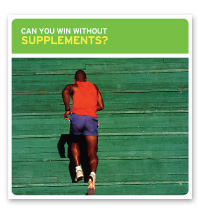Major League Among Those Interested in Sport Supplements’ Predictor

While most research on young athletes and their use of sports supplements focuses on the product, University of Alabama professor Mike Perko goes in a completely different direction—what got the athletes interested in them in the first place?
“Most researchers still tend to focus on the product rather than the process – the supply rather than the demand. In my opinion, it should be just the opposite. Waiting to survey what athletes are currently taking (the typical approach) – be it steroids or Creatine – is all wrong. You need to intervene well before they are even thinking about it,” says Perko, author of “Taking One for the Team: The New Thinking On Dietary Supplements and Young Athletes.”
“After all, athletes don’t just wake up one day and say, ‘Hey, I think I’ll take some steroids.”
Perko’s research focuses on athletes’ decision-making process about these products and the “gut feelings” and external influences that either help athletes resist the products or encourage their use.
From his doctoral dissertation in the early 1990s, came the development of “The Survey to Predict Adolescent Athlete Supplement Use.” Between 1998-2001, this 36-question survey was administered to more than 4,000 male and female teen athletes across the southeastern United States. Perko, the chair of the health sciences department within the College of Human Environmental Sciences, has received requests to use the survey from all over the world, including Major League Baseball.

“This theory-based prediction instrument can be used to determine attitudes, beliefs, and subjective norms of young athletes and their likely use or non-use of potentially harmful dietary supplement products.”
In addition to predicting, with some assurity, the likelihood of the athlete later taking supplements, the survey also points out whether the person’s external environment or an internal decision will be most influential.
“By knowing this information, you can develop education that focuses on that specific aspect of how athletes make decisions, rather than putting all athletes in one gym and delivering one simple message of ‘don’t do this,’” says Perko.
According to the athletes surveyed, parents, physicians and athletic trainers are those most likely to influence young athletes away from use, while coaches and the media are most likely to influence toward use.
“With supplements, a teen’s gut feeling can say ‘I shouldn’t take this,’ but is often outweighed by the world they live in — say a coach who says ‘you put on 10 pounds by next year, and you’ll start’ or your parents saying ‘hey that’s great because you can get a scholarship.’”
Possessions of steroids became a felony in 1990, thanks, in part, to Perko’s Senate testimony calling for such action.
However, there were unintended consequences. Sales of over the counter dietary supplements, touted as steroid alternatives, took off.
“As a former coach, it was easy to see that athletes wouldn’t just stop taking performance-enhancers just because one type was now illegal. Athletes were still looking for an edge. They had taken away the supply, but done nothing about the demand.

“With the current emphasis on steroids, it is a natural progression to want to take something that is considered ‘safe,’” Perko says. However, dietary supplements are not safe, he says.
“Clearly, the biggest danger is knowing what’s really in that bottle,” says Perko. “There are no safeguards to assure anyone that what’s advertised is in the bottle. Next, the multitude of ingredients in sports supplements with no human or animal testing is enormous.”
The potential for allergic reactions or detrimental impacts from the combined effects of various ingredients on the young, growing body are often not contemplated.
“Enough young athletes have had serious health problems, including death, that various states have placed strong restrictions on their sale.
Surveys indicate 48 percent of Americans don’t know that supplements are not regulated by some government agency. Current law does not require supplement companies to go through the FDA before selling their products, and products can only be pulled by the FDA if they are known to cause injury or death.
“With laws like that on the books, it’s easy to see how in less than 10 years, dietary supplements have gone from a cottage industry with sales of $600 million to a $20 billion industry today,” Perko says.
“If you just go down the aisle at Walmart, there are things you can’t even pronounce and, unfortunately, it’s up to the consumer to make decisions about them.
“With 53 million kids playing youth sports in America, the most important message is that sports performance should come about through hard work, proper nutrition and fair play, not a pill or powder.”
Further Reading